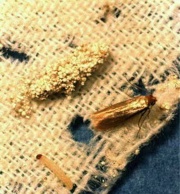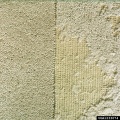Difference between revisions of "Clothes moth"
m (Text replace - "== Authority ==" to "== Sources Checked for Data in Record ==") |
|||
| Line 12: | Line 12: | ||
| − | == | + | == Sources Checked for Data in Record == |
* George Savage, ''Art and Antique Restorer's Handbook'', Rockliff Publishing Corp, London, 1954 | * George Savage, ''Art and Antique Restorer's Handbook'', Rockliff Publishing Corp, London, 1954 | ||
Revision as of 15:05, 29 April 2016
Description
Any of various moths of the family Tineidae. The larvae of the clothes moths feed on wool, hair, fur, feathers, cotton, and silk. The adult clothes moth is small with a wingspan of 12 to 26 mm (0.5 to 1.0 inch). The common or webbing clothes moth (Tineola bisselliella) is straw color and has a naked larva that spins a thin webbing of Silk over its food. The Casemaking clothes moth (Tinea pellionella) is grayish yellow or brown with darker brown spots on its forewings. Its larvae live within a case composed of bits of the food material bound together with silk. The carpet or tapestry moth (Trichophaga tapetiella) produces a small tube for its larvae made from bits of carpet or fabric. All of these types are readily susceptible to commercial insecticides, and repellents.
Additional Images
Sources Checked for Data in Record
- George Savage, Art and Antique Restorer's Handbook, Rockliff Publishing Corp, London, 1954
- Random House, Webster's Encyclopedic Unabridged Dictionary of the English Language, Grammercy Book, New York, 1997
- John S. Mills, Raymond White, The Organic Chemistry of Museum Objects, Butterworth Heineman, London, 2nd ed., 1994
- The American Heritage Dictionary or Encarta, via Microsoft Bookshelf 98, Microsoft Corp., 1998


